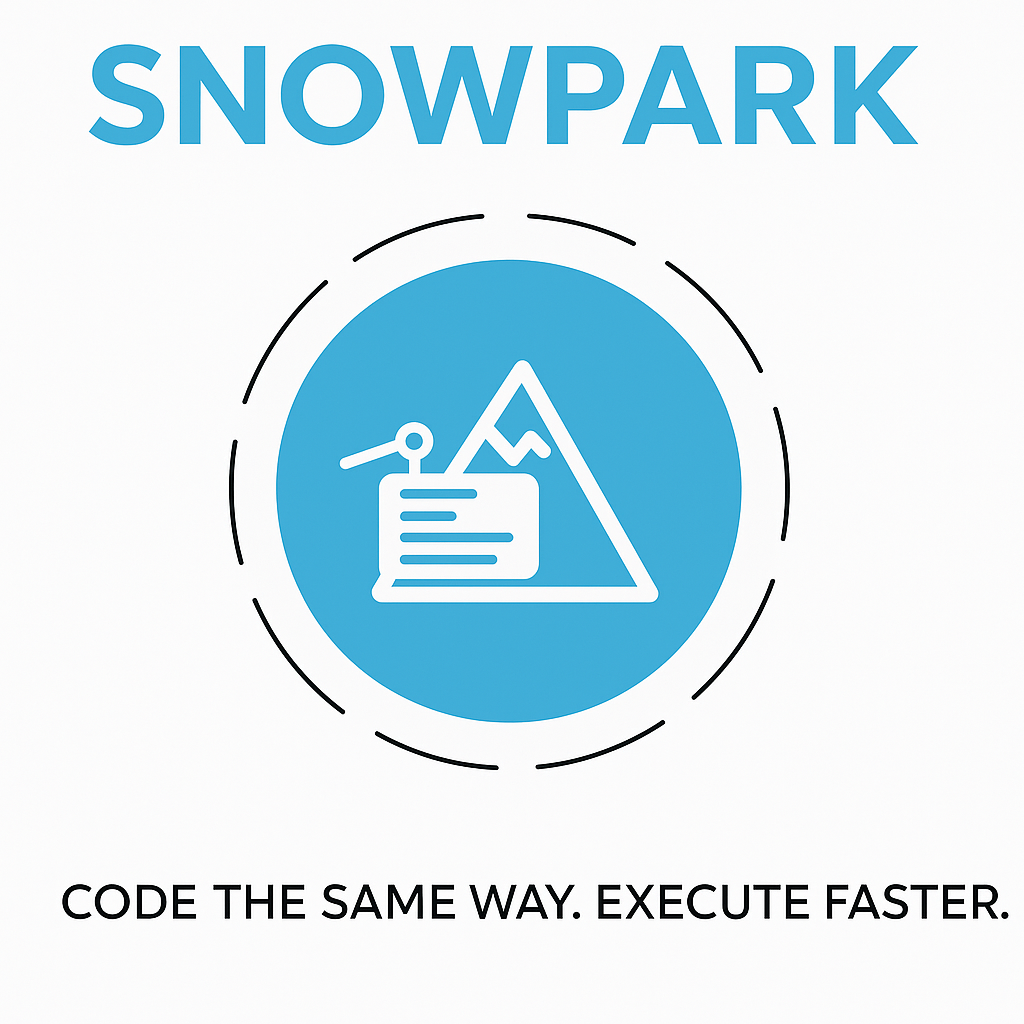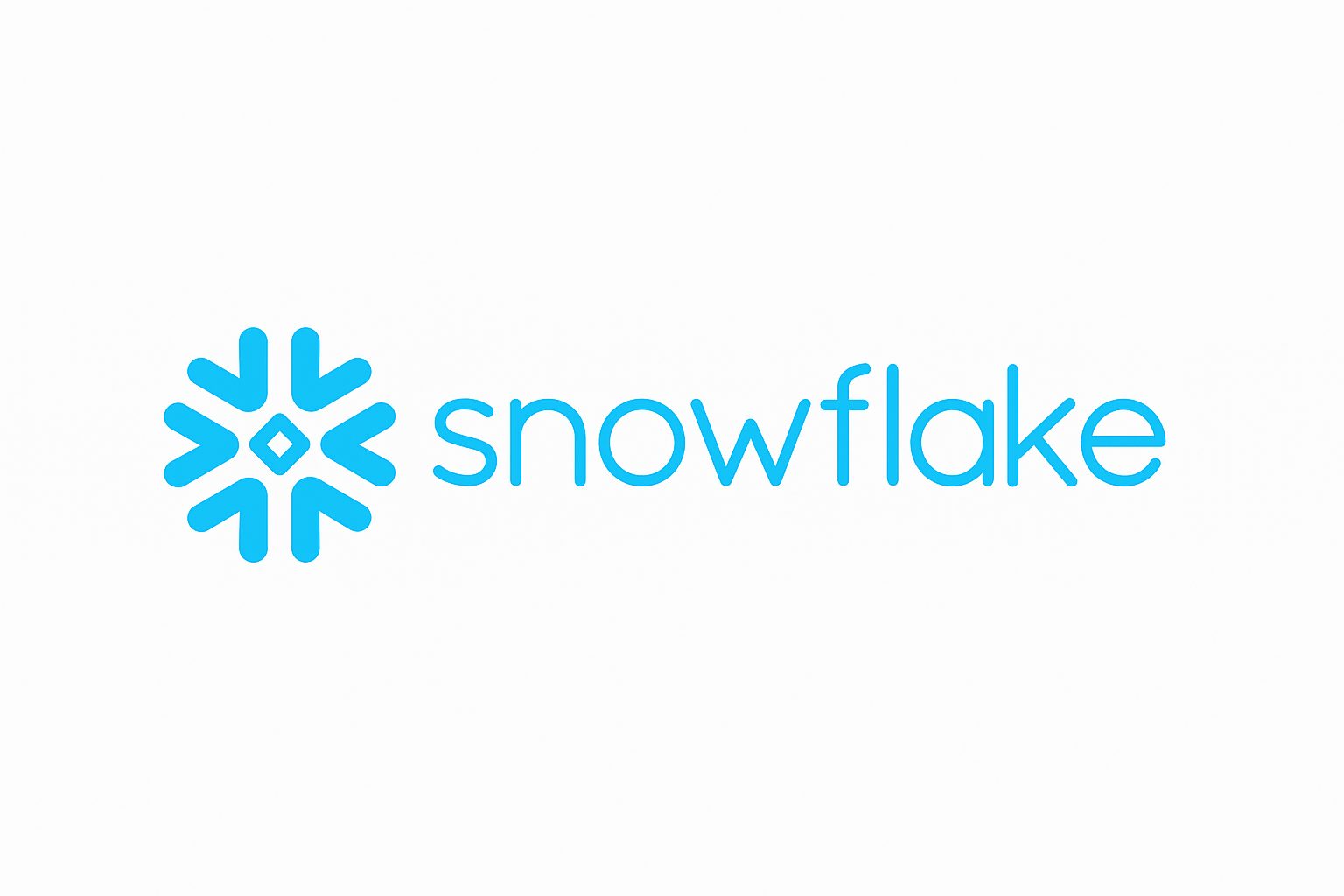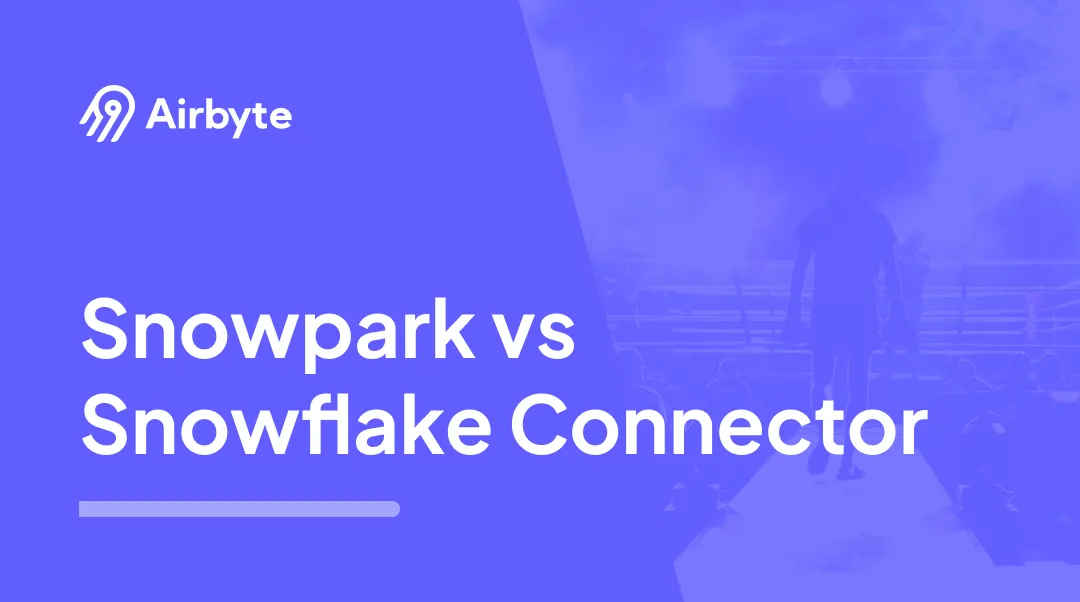Snowpark vs Snowflake Connector: Five Critical Aspects
Summarize this article with:
✨ AI Generated Summary
Snowpark and the Snowflake Connector offer distinct approaches for Snowflake data processing: Snowpark enables native, in-database computation with DataFrame APIs supporting complex transformations, ML workflows, and AI integration, while the Connector facilitates secure, high-performance external application integration and data movement.
- Snowpark excels in large-scale analytics, ML model deployment, and AI-powered operations with automatic SQL translation and optimized resource use.
- The Connector supports advanced authentication, real-time application connectivity, and bulk data transfers, ideal for ETL/ELT and dashboard responsiveness.
- Hybrid architectures combining Snowpark, the Connector, and Airbyte ingestion provide flexible, scalable, and secure enterprise data pipelines.
When most of data engineers report experiencing burnout while daily global data generation is projected to reach 463 exabytes in the near future, the tools you choose for Snowflake data processing can make the difference between sustainable success and operational chaos. Two primary approaches dominate this landscape: Snowpark and the Snowflake Connector. While both enable powerful data interactions within Snowflake's cloud ecosystem, their architectural philosophies and use-case strengths differ dramatically.
For data professionals navigating Snowflake's expanding capabilities, choosing the optimal approach requires understanding not just feature sets, but how these tools align with modern data-engineering workflows, machine-learning operationalization, and enterprise governance requirements. This comprehensive analysis examines Snowpark and the Snowflake Connector across five critical dimensions, providing the strategic insights needed to optimize your data-architecture decisions.
What Is Snowpark and How Does It Transform Data Processing?

Snowpark represents a paradigm shift in cloud data processing, functioning as a unified data-processing and analytics engine built directly within the Snowflake Data Cloud. Unlike traditional approaches requiring separate compute clusters and data movement, Snowpark brings computation to your data by executing native Scala, Java, and Python workloads inside Snowflake's elastic infrastructure. This architecture eliminates the complexity of maintaining external Spark clusters while providing the familiar DataFrame programming interface that data engineers and scientists depend on.
The platform's revolutionary approach centers on lazy evaluation and query push-down optimization. When you write Python or Scala code using Snowpark's DataFrame API, the system automatically translates these operations into optimized SQL that executes within Snowflake's proven query engine. This means your complex data transformations, machine-learning workflows, and analytical operations benefit from Snowflake's automatic scaling, security governance, and performance optimizations without requiring separate infrastructure management.
Key architectural advantages of Snowpark include:
- Familiar DataFrame syntax with automatic SQL translation for optimal performance within Snowflake's engine
- Seamless integration with Snowflake features including UDFs, stored procedures, and native ML capabilities
- Unified analytics experience supporting exploratory data analysis, machine-learning model deployment, and real-time stream processing
- Enhanced performance and scalability through automatic optimization and elastic compute resource allocation
- AI-powered functions for natural-language processing and computer-vision workflows directly within DataFrames
- Artifact Repository integration enabling seamless third-party library management for custom UDFs and stored procedures
Snowpark's latest developments include AI functions in private preview, allowing developers to perform sentiment analysis, content filtering, and text generation directly within DataFrame operations. The platform's evolution toward supporting containerized applications through Snowpark Container Services further positions it as a comprehensive platform for modern data applications.
How Does the Snowflake Connector Enable Application Integration?

The Snowflake Connector serves as a sophisticated bridge API that establishes secure, high-performance communication channels between external applications and Snowflake's Data Cloud. Rather than processing data within Snowflake like Snowpark, the Connector excels at programmatic data access, enabling Python, Java, and Scala applications to execute SQL queries, transfer data, and manage database operations through standardized protocols.
Recent enhancements have expanded the Connector's capabilities beyond basic database communication, including the introduction of OAuth 2.0 Authorization Code Flow and Client Credentials Flow for enterprise-grade authentication options, and token-caching mechanisms to optimize connection management for high-frequency applications.
Essential capabilities of the Snowflake Connector include:
- Advanced authentication mechanisms including OAuth 2.0, multi-factor authentication, and enterprise SSO integration
- Optimized data movement with bulk operations, parameter binding, and result batching for large-scale transfers
- Secure connection management featuring encrypted communication, role-based access control, and comprehensive audit logging
- Simplified development workflows through pre-built drivers, comprehensive APIs, and automated connection pooling
- Enhanced data accessibility enabling real-time application integration and responsive dashboard experiences
- Performance-optimization features including connection reuse, batch processing, and parallel query execution capabilities
The Connector's evolution toward supporting Iceberg table operations and enhanced security features positions it as a critical component for enterprises requiring programmatic Snowflake access while maintaining strict governance and performance requirements.
What Are the Key Performance Differences Between Snowpark and the Snowflake Connector?
Performance characteristics fundamentally distinguish Snowpark's in-database processing from the Connector's application-centric approach. Snowpark's architectural advantage lies in eliminating data movement through native execution within Snowflake's optimized query engine, while the Connector excels in scenarios requiring external processing capabilities and application-integration flexibility.
Query Execution and Data Processing Speed
Snowpark demonstrates significant performance advantages for large-scale data-manipulation tasks, with benchmark studies showing up to 24× faster processing for complex in-database operations compared to traditional connector-based approaches.
This performance gain stems from query push-down optimization, where DataFrame operations compile into optimized SQL executed entirely within Snowflake's parallel-processing architecture.
The Connector's strength emerges in high-concurrency scenarios requiring rapid connection establishment and result retrieval. Recent performance optimizations—including multi-process fetching and connection pooling—aim to improve the Connector's ability to handle concurrent requests and may help support real-time application back-ends and interactive dashboards, though no official benchmarks specifically quantify the increase or directly confirm sub-second response suitability.
Snowpark Join Performance and Resource Utilization
Snowpark's tight integration with Snowflake's compute engine reduces warehouse consumption through intelligent query optimization and automatic resource scaling. Snowpark-optimized warehouses provide 16× more memory per node, enabling memory-intensive machine-learning workflows and complex analytical operations without external infrastructure costs. The platform's join optimization capabilities ensure complex multi-table operations execute efficiently within Snowflake's distributed architecture.
The Connector's resource efficiency depends on client-side architecture and query patterns. Batch processing with appropriate fetch sizes helps reduce client-memory consumption when handling billion-row datasets, while connection pooling minimizes authentication overhead in high-frequency applications.
Real-World Performance Scenarios
- Large-scale analytics and transformations benefit from Snowpark's native parallel processing, particularly for operations involving complex joins, window functions, and aggregations across massive datasets.
- Interactive applications and dashboards leverage the Connector's optimized connection management and result caching for responsive user experiences.
- Machine-learning workflows achieve superior performance through Snowpark's in-database feature engineering and model-training capabilities, eliminating data export requirements.
- Real-time data ingestion utilizes the Connector's bulk-upload optimizations for high-throughput streaming scenarios.
Optimization strategies for both tools include proper warehouse sizing, query-pattern analysis, and leveraging Snowflake's automatic clustering and materialized-view capabilities to enhance overall system performance.
How Do Machine Learning and AI Workflows Differ Between These Approaches?
The integration of machine-learning and AI capabilities represents a critical differentiator between Snowpark and the Snowflake Connector, particularly as organizations increasingly prioritize AI-driven analytics and generative-AI applications within their data platforms.
Snowpark's Native ML Ecosystem
Snowpark ML provides a comprehensive framework for end-to-end machine-learning workflows entirely within Snowflake's security perimeter. The platform's modeling API supports scikit-learn-compatible preprocessing and feature engineering at scale, utilizing Snowpark-Optimized Warehouses for distributed computation without data movement. Model deployment occurs through the Snowpark Model Registry, which enables versioned deployment of Python ML models as native Snowflake UDFs with automated dependency management.
The recent introduction of AI functions in private preview transforms how data scientists approach analytical workflows. Functions enable content moderation and data-quality checks using natural-language prompts, while new capabilities integrate large language models directly into DataFrame operations. These capabilities allow organizations to perform sentiment analysis, text classification, and content generation without exporting sensitive data to external AI services.
Snowpark's approach to ML operationalization enables integration of hyper-parameter tuning, cross-validation, and model monitoring within Snowflake's governance framework, though tuning and validation require user implementation or external frameworks. Feature-engineering pipelines execute at data-warehouse scale, supporting real-time inference through automatically generated UDFs that maintain consistent performance characteristics across batch and streaming workloads.
Connector-Based ML Integration Patterns
The Snowflake Connector enables ML workflows through integration with external platforms and libraries, providing flexibility for organizations with existing ML-infrastructure investments. Data scientists can extract feature sets using optimized bulk operations, train models in preferred environments like Databricks or SageMaker, and deploy results back to Snowflake for scoring and application integration.
Advanced connector patterns include streaming-ML inference pipelines where models hosted in external services score data as it arrives in Snowflake. The Connector's OAuth 2.0 integration enables secure, automated model-retraining workflows that maintain data lineage and audit compliance across hybrid-cloud environments.
AI-Powered Data-Engineering Workflows
Both approaches support AI-enhanced data-engineering, though with different architectural implications. Snowpark's AI Assistant auto-generates DataFrame transformations from natural-language descriptions, accelerating pipeline development while maintaining optimization for Snowflake's execution engine. The Connector enables integration with external AI code-generation tools and automated data-quality platforms that leverage LLMs for schema validation and anomaly detection.
Organizations implementing generative-AI applications benefit from Snowpark's vector-database capabilities and native unstructured-data processing, enabling retrieval-augmented-generation workflows that maintain enterprise security and governance requirements. The Connector supports these use cases through high-performance vector-similarity search and bulk embedding operations for external vector databases.
What Performance-Optimization Techniques and Best Practices Should You Implement?
Optimizing performance across Snowpark and Snowflake Connector implementations requires understanding their distinct architectural approaches and applying targeted techniques that leverage each platform's strengths while mitigating potential bottlenecks.

Snowpark-Specific Optimization Strategies
- Column pruning through explicit field selection reduces intermediate dataset sizes by 40-60 % compared with
SELECT *operations. - Predicate push-down ensures filter conditions apply before expensive join operations, decreasing processing costs by up to 70 % in benchmark tests.
- UDF vectorization with
@vectorizeddecorators enables batch processing that achieves 30 % faster execution than row-by-row operations. - Snowpark-optimized warehouses with expanded memory allocation are essential for memory-intensive workflows, particularly for machine-learning feature engineering.
- Concurrency optimization through proper warehouse sizing and scaling policies aligns with Snowpark's parallel-execution model.
Connector Performance-Enhancement Techniques
- Asynchronous query execution with intelligent connection pooling handles significantly higher concurrent loads than synchronous approaches.
- Batch-processing optimization via
fetchmany()with appropriate batch sizes reduces client-memory consumption while maintaining performance. - Parameter binding and prepared-statement caching can provide significant performance improvements over dynamic SQL generation, though the exact magnitude of the benefit may vary depending on workload and environment.
Cross-Platform Optimization Principles
Both platforms benefit from:
- Intelligent SQL optimization and proper indexing within Snowflake
- Automatic clustering on frequently filtered columns
- Materialized-view utilization for complex, predictable queries
- Thoughtful warehouse auto-suspend/auto-resume policies
- Network optimization via result caching and compression settings
What Are the Functional Capabilities and Use-Case Strengths?
How Do Security Models and Governance Capabilities Compare?
What Integration Patterns and Ecosystem Compatibility Should You Consider?
Hybrid architectures often combine both tools—using connector-based ingestion, Snowpark transformations, and connector-based application delivery—to maximize flexibility and performance.
What Does the Future Hold for Snowpark–Snowflake Development?
- Snowpark: recent enhancements focus on AI integrations and scalable container services, with ongoing expansion of language model access via Snowflake Cortex.
- Snowflake Connector: improvements continue in reliability and integration, with Snowpipe enabling enhanced data streaming support.
- Convergence: unified dev experiences merging DataFrame programming with application connectivity and seamless hybrid-cloud data management.
How Does Airbyte Enhance Snowflake Data-Integration Capabilities?
While Snowpark and the Snowflake Connector excel at processing and accessing data inside Snowflake, end-to-end strategies require robust ingestion from diverse sources. Airbyte fills this gap with 600+ pre-built connectors, AI-powered connector generation, and enterprise-grade security. Snowflake Cortex can automatically vectorize unstructured data after Airbyte's connector loads it, enabling accelerated AI pipelines and potentially reducing ingestion costs versus some alternatives; however, specific performance claims require independent validation.
Snowflake-Specific Advantages
- Automatic vectorization for retrieval-augmented-generation use cases
- Advanced support for unstructured sources (Google Drive, SharePoint, multimedia)
- Push-down transformations to minimize egress fees and warehouse costs
Governance & Security
Airbyte Self-Managed Enterprise keeps sensitive data within your infrastructure, offers column-level hashing, RBAC, audit logging, and SSO/OAuth 2.0 integration—aligning with Snowflake's security posture.
Complementary Workflow Pattern
- Airbyte streams data into Snowflake raw tables.
- Snowpark stored procedures transform and enrich the data.
- Connector-based apps deliver insights via dashboards and automated reports.
Final Recommendations
Choose Snowpark when you need:
- Native, large-scale transformations and analytics
- In-database ML training and AI integration
- Familiar DataFrame programming for data-science teams
Choose the Snowflake Connector when you require:
- Programmatic integration with external apps
- High-concurrency, real-time access patterns
- Custom authentication flows and hybrid-cloud architectures
Adopt a hybrid approach for:
- Comprehensive pipelines from ingestion to analytics
- Diverse team skill sets and evolving requirements
- Enterprise environments demanding both governance and flexibility
By strategically combining Snowpark, the Snowflake Connector, and Airbyte, organizations can build future-ready data architectures that scale with business growth and technological advancement.
FAQs
What is the main difference between Snowpark and the Snowflake Connector?
Snowpark executes data processing natively inside Snowflake using DataFrame APIs that translate into optimized SQL. The Connector, on the other hand, serves as a bridge for external applications to securely query, insert, or manage Snowflake data programmatically.
Which tool is better for machine-learning workflows?
Snowpark is typically better suited for ML because it allows preprocessing, feature engineering, and even model deployment directly inside Snowflake without data movement. The Connector is useful if your ML pipelines rely on external environments like Databricks or SageMaker.
Can Snowpark and the Connector be used together?
Yes. Many enterprises adopt a hybrid model: Airbyte or the Connector handles ingestion and application integration, while Snowpark executes heavy transformations, AI workflows, and in-database analytics.
Does Snowpark support Python?
Yes. Snowpark supports Scala, Java, and Python. Its Python DataFrame API allows developers to write familiar code that is automatically translated into SQL and executed inside Snowflake’s compute engine.
How does security differ between the two?
Snowpark leverages Snowflake’s built-in authentication, encryption, and RBAC policies automatically. The Connector supports OAuth 2.0, SSO, and token caching, giving developers more control over external authentication and application-level governance.

.webp)
